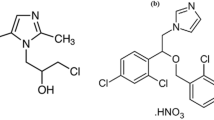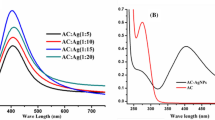Abstract
Widespread use of antibiotics for humans and animals health has led to drugs entering the environment, such as lakes and streams worldwide. It is imperative to develop methods to screen these in drinking water supplies. We developed a novel nanoparticles-based probe to detect the β-lactam skeleton 6-APA. Cationic ligand thiopyridine stabilized silver nanoparticles (ThPy-AgNPs) were synthesized and used for chemosensing of the drug 6-aminopenicillanic acid (6-APA). Along with several drugs, during UV–visible titration with ThPy-AgNPs, a distinctive decrease in surface plasmon resonance bands absorbance was observed with 6-APA. The ThPy-AgNPs-based detection system for 6-APA is based on the phenomenon of de-aggregation and is monitored by using UV–visible spectrophotometry and atomic force microscopy measurements. The process is relatively rapid, highly specific and selective for 6-APA when tested against several other drugs. This optical method can recognize 6-APA as low as 1 μM concentration, and drug detection is independent of the pH of media. Moreover, the optimized sensing protocol is able to sense 6-APA in human blood plasma samples and is not altered by presence of other interfering drugs. It is anticipated that this method will be of immense value to detect 6-APA for blood samples and drinking water.







Similar content being viewed by others
References
Abdalla MA (1991) Selective spectrophotometric determination of some cephalosporins in pharmaceutical formulations. Anal Lett 24:55–67
Ali M, Mohammad A (1994) Polarogaphic determination of cephradine in aqueous and biological media. Bioelectrochem Bioenerg 33:201–204
Amendola V, Bakr OM, Stellacci F (2010) A study of the surface plasmon resonance of silver nanoparticles by the discrete dipole approximation method: effect of shape, size, structure, and assembly. Plasmonics 5:85–97
Anwar A, Shah MR, Muhammad SP, Afridi S, Ali K (2016) Thio-pyridinium capped silver nanoparticle based supramolecular recognition of Cu(I) in real samples and T-lymphocytes. New J Chem 40:6480–6486
Ateeq M, Shah MR, Bano S, Anis I, Faizi S, Bertino MF, Sohaila Naz S (2014) Green synthesis and molecular recognition ability of patuletin coated gold nanoparticles. Biosens Bioelectron 63:499–505
Bae CH, Nam SH, Park SM (2002) Formation of silver nanoparticles by laser ablation of a silver target in NaCl solution. Appl Surf Sci 197–198:628–634
Devani M, Patel IT, Patel T (1992) Spectrophotometric determination of ampicillin and its dosage forms. Talanta 39:1391–1394
Dı́az-Cruz MS, López de Alda MJ, Barceló D (2003) Environmental behavior and analysis of veterinary and human drugs in soils, sediments and sludge. Trends Anal Chem 22:340–351
Fisher JF, Meroueh SO, Mobashery S (2005) Bacterial resistance to β-Lactam antibiotics: compelling opportunism, compelling opportunity. Chem Rev 105:395–424
Gonzalez AL, Noguez C, Ortiz GP, Rodriguez-Gattorno G (2005) Optical absorbance of colloidal suspensions of silver polyhedral nanoparticles. J Phys Chem B 109:17512–17517
Jung JH, Lee JH, Shinkai S (2011) Functionalized magnetic nanoparticles as chemosensors and adsorbents for toxic metal ions in environmental and biological fields. Chem Soc Rev 40:4464–4474
Leszczynska E, Koncki R, Glab S (1996) Biosensors with immobilized penicillin aminohydrolase and penicillinase for determination of β-lactam antibiotics. Chem Anal 41:839–844
Link S, El-Sayed MA (1999) Spectral properties and relaxation dynamics of surface plasmon electronic oscillations in gold and silver nanodots and nanorods. J Phys Chem B 103:8410–8426
Liu Q, Zhou Q, Jiang G (2014) Nanomaterials for analysis and monitoring of emerging chemical pollutants. Trends Anal Chem 58:10–22
Matagne A, Lamotte-Brasseur J, Frère JM (1998) Catalytic properties of class A beta-lactamases: efficiency and diversity. Biochem J 330:581–598
Mulvaney P (1996) Surface plasmon spectroscopy of nanosized metal particles. Langmuir 12:788–800
Ohkubo Y, Seino S, Kageyama S, Kugai J, Nakagawa T, Ueno K, Yamamoto T (2014) Effect of decrease in the size of Pt nanoparticles using sodium phosphinate on electrochemically active surface area. J Nanopart Res 16:1–9
**ali KC, Deng S, Rockstraw DA (2008) Effect of ammonium nitrate on nanoparticle size reduction. Res Lett Nanotechnol 2008:756843
Pinto CG, Pavon JLP, Cordero BM (1995) Micellar liquid chromatography of zwitterions: retention mechanism of cephalosporins. Analyst 120:53–62
Poole CF (2003) New trends in solid-phase extraction. Trends Anal Chem 22:362–373
Prathna T, Chandrasekaran N, Mukherjee A (2011) Studies on aggregation behaviour of silver nanoparticles in aqueous matrices: effect of surface functionalization and matrix composition. Colloids Surf A Physicochem Eng Asp 390:216–224
Saha K, Agasti SS, Kim C, Li X, Rotello VM (2012) Gold nanoparticles in chemical and biological sensing. Chem Rev 112:2739–2779
Sanderson H, Johnson DJ, Reitsma T, Brain RA, Wilson CJ, Solomon KR (2004) Ranking and prioritization of environmental risks of pharmaceuticals in surface waters. Regul Toxicol Pharmacol 39:158–183
Scheurell M, Franke S, Shah MR, Hühnerfuss H (2009) Occurrence of diclofenac and its metabolites in surface water and effluent samples from Karachi, Pakistan. Chemosphere 77:870–876
Selke S, Scheurell M, Shah MR, Hühnerfuss H (2010) Identification and enantioselective gas chromatographic mass-spectrometric separation of desmethylnaproxen, the main metabolite of the drug naproxen, as a new environmental contaminant. J Chromatogr A 1217:419–423
Shah K, Hassan E, Ahmed F, Anis I, Rabnawaz M, Shah MR (2017) Novel fluorene-based supramolecular sensor for selective detection of amoxicillin in water and blood. Ecotoxicol Environ Saf 141:25–29
Shamsipur M, Talebpour Z, Bijanzadeh HR, Tabatabaei S (2002) Monitoring of ampicillin and its related substances by NMR. J Pharm Biomed Anal 30:1075–1085
Tyczkowska KL, Voyksner RD, Aronson AL (1992) Solvent degradation of cloxacillin in vitro: tentative identification of degradation products using thermospray liquid chromatography-mass spectrometry. J Chromatogr A 594:195–201
Wilson BA, Smith VH, deNoyelles F, Larive CK (2003) Effects of three pharmaceutical and personal care products on natural freshwater algal assemblages. Environ Sci Technol 37:1713–1719
Wishart D (1984) Recent advances in antimicrobial drugs: the penicillins. J Am Vet Med Assoc 185:1106–1108
Yang J, Zhou G, Cao X, Ma Q, Dong J (1998) Study on the fluorescence characteristics of alkaline degradation of cefadroxil, cephradine, cefotaximum sodium and amoxicillin. Anal Lett 31:1047–1060
Yang X, Zhu S, Dou Y, Zhuo Y, Luo Y, Feng Y (2014) Novel and remarkable enhanced-fluorescence system based on gold nanoclusters for detection of tetracycline. Talanta 122:36–42
Acknowledgements
The authors are thankful of Higher Education Commission (HEC) Pakistan, and Sunway University for their support.
Author information
Authors and Affiliations
Corresponding author
Ethics declarations
Conflict of interest
None.
Additional information
Editorial responsibiility: Binbin Huang.
Electronic supplementary material
Below is the link to the electronic supplementary material.
Rights and permissions
About this article
Cite this article
Anwar, A., Shah, M.R., Muhammad, S.P. et al. Synthesis of 4-formyl pyridinium propylthioacetate stabilized silver nanoparticles and their application in chemosensing of 6-aminopenicillanic acid (APA). Int. J. Environ. Sci. Technol. 16, 1563–1570 (2019). https://doi.org/10.1007/s13762-018-1745-4
Received:
Revised:
Accepted:
Published:
Issue Date:
DOI: https://doi.org/10.1007/s13762-018-1745-4




